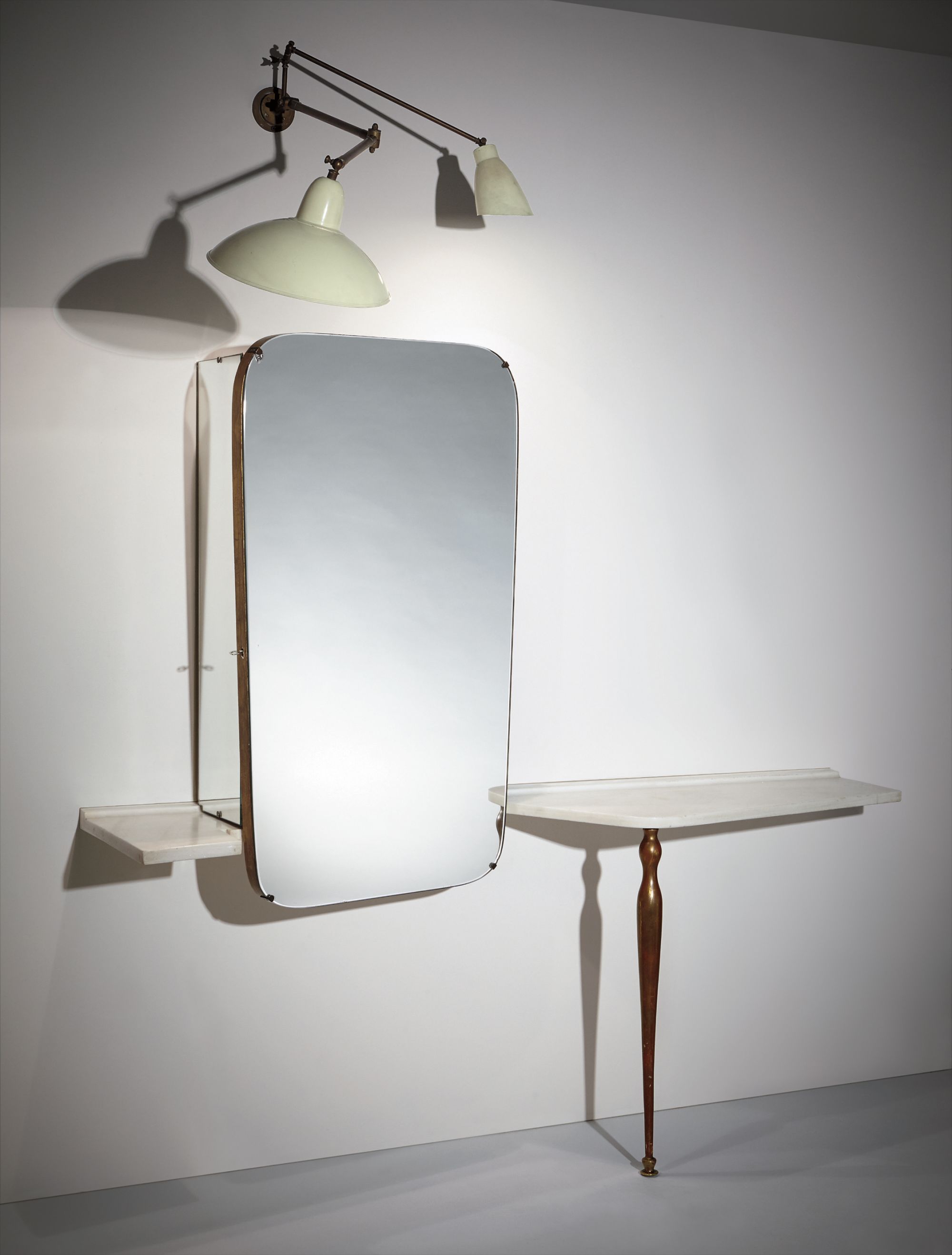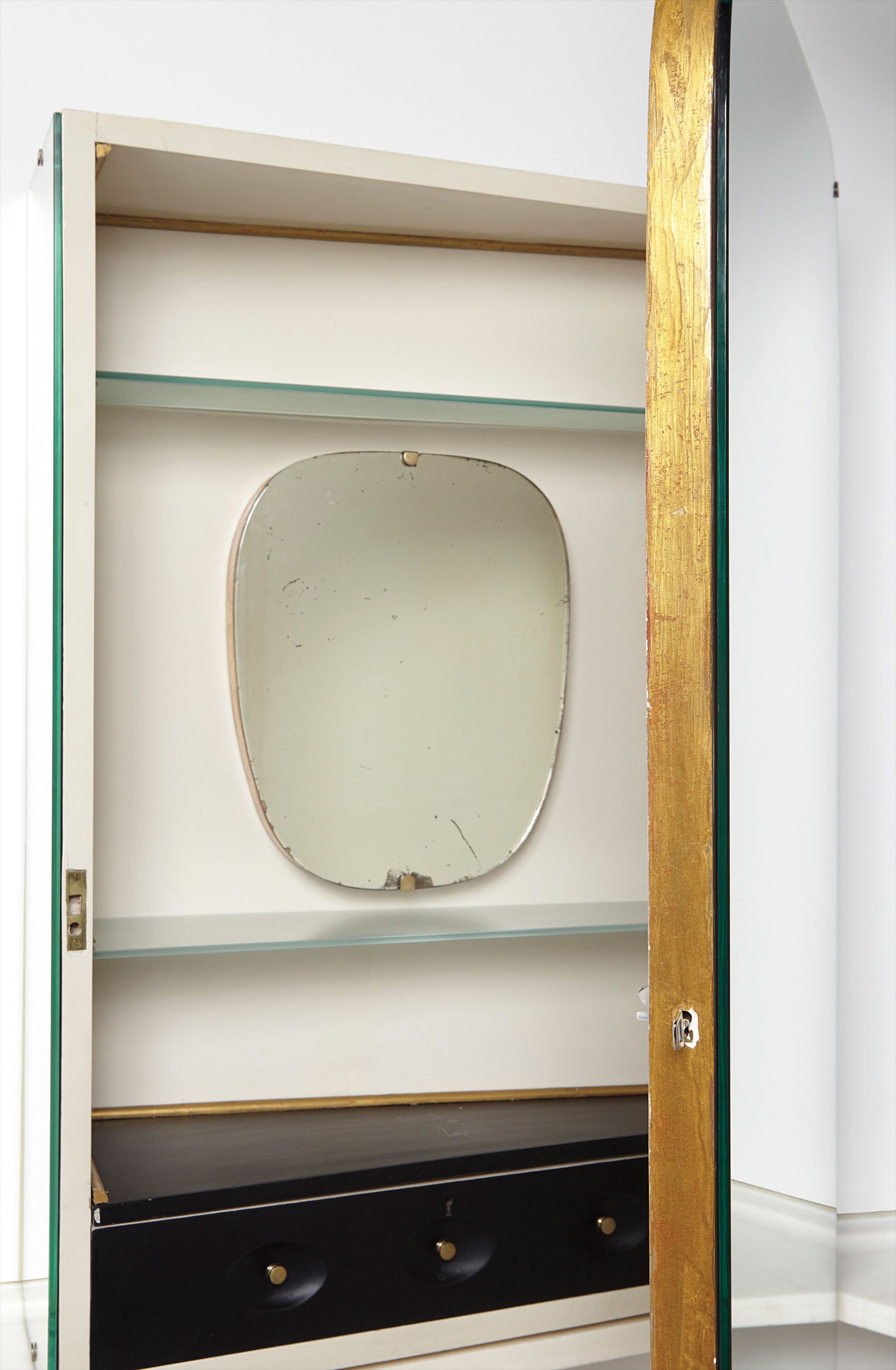





425
Carlo Mollino
Unique "specchio-armadio" and adjustable wall light, from the bedroom of the Ada and Cesare Minola House, Turin
Wall light: 38 in. (96.5 cm) deep, fully extended
Full-Cataloguing
Phillips would like to thank Fulvio Ferrari and Napoleone Ferrari from the Museo Casa Mollino for their assistance cataloguing the present lot.
The “Free Enthusiasm” of Carlo Mollino’s Minola Commission
By Fulvio Ferrari
The Ada and Cesare Minola House is one of the most important interior projects of Carlo Mollino’s entire career. The numerous prospectuses and technical drawings created between 1944 and 1946 testify to Mollino’s great interest in the project, despite the difficulties from the ongoing World War and the continuous bombardments of his city, Turin.
The relationship between the architect and his client benefited from particular circumstances: Ada Minola was in fact an artist who painted and designed jewels (Paola Stroppiana, Gioielli Vertiginosi, Milan, 2016) and who, more importantly, shared with Mollino a deep knowledge of Art Nouveau and its culture. The project is therefore made special by the rarity of a refined commissioner used to living closely with art; a special client who would inspire Mollino to create designs up until 1964.
In 1948 the Minola house was featured in depth in Domus, where Gio Ponti described “furniture of precious manufacture, delicate and refined,” emphasizing the “artistic value” of the project and comparing the elements from the interior to the creations originating from “the free enthusiasm for the extraordinary ideals of ancient times.”
The one-legged "specchio-armadio" from the bedroom is a clear reference to baroque corner units, a connection which Mollino reinforced with the use of gilding. The structure was dealt with in a new way. The overall appearance of the unit is disjointed and free, like a sculpture. The configuration of the shelves, made of exceptionally hand-shaped marble, appear suspended while the mirrored door hides a makeup cabinet fitted with a second, smaller, “private” mirror.
Collectively, these elements constitute a unique work presenting a high level of engineering, as found in some musical instruments. Of equal value, the engineering of the lighting involves the use of a unit that is separated from the main body of the piece. With various joints and shades of different shapes, the wall light allows for the adjustment of its intensity and rays in any direction desired. Sketches by the architect’s own hand testify to the ardor with which he created this part of Ada’s interior in 1945.
Placed between the yellow-gold velvet armchairs and the purple velvet curtains of the living room, the two lounge chairs in black fabric were highlighted by Ponti in connection to the “natural and romantic dynamism of the form.” The two were in fact displayed in front of an etching illustrating a waterfall. The use of black symbolised the importance of these formidable objects (the table facing the chairs, the marble shelf, the table legs, and the legs of the chairs were also black).
The inclusion of a pair of chairs that recall a nineteenth-century aesthetic can be attributed to Mollino’s ability to create an interior that tells a story, glorifying the relics of the family’s past (furniture, works of art, and antique rugs) always found in important aristocratic residences. The two buttons on the curved seatback upholstery evoke a pair of worried eyes, as if they belonged to a surrealist creature with golden legs.
Carlo Mollino
Italian | B. 1905 D. 1973Carlo Mollino made sexy furniture. His style may have grown out of the whiplash curves of Art Nouveau, but the sinuous lines of his furniture were more humanoid than vegetal, evoking arched backs and other body parts. Mollino was also an avid aviator, skier and racecar driver — he designed his own car for Le Mans. His love of speed and danger comes across in his designs, which MoMA curator Paola Antonelli has described as having "frisson."
Mollino had no interest in industrial design and the attendant constraints of material costs and packaging. His independent wealth allowed him to pick and choose projects, resulting in an oeuvre of unique, often site-specific works that were mostly executed by the Turin joinery firm Apelli & Varesio. Apart from a coffee table that he designed in 1950 for the American company Singer & Sons, his furniture never went into production. Notwithstanding the support of Gio Ponti, Mollino's design contemporaries largely dismissed him as an eccentric outsider. However, the combination of scarcity (Mollino only made several hundred works in his lifetime), exquisite craftsmanship and idiosyncratic "frisson" has rightly placed Carlo Mollino in the highest tier of twentieth-century design collecting.